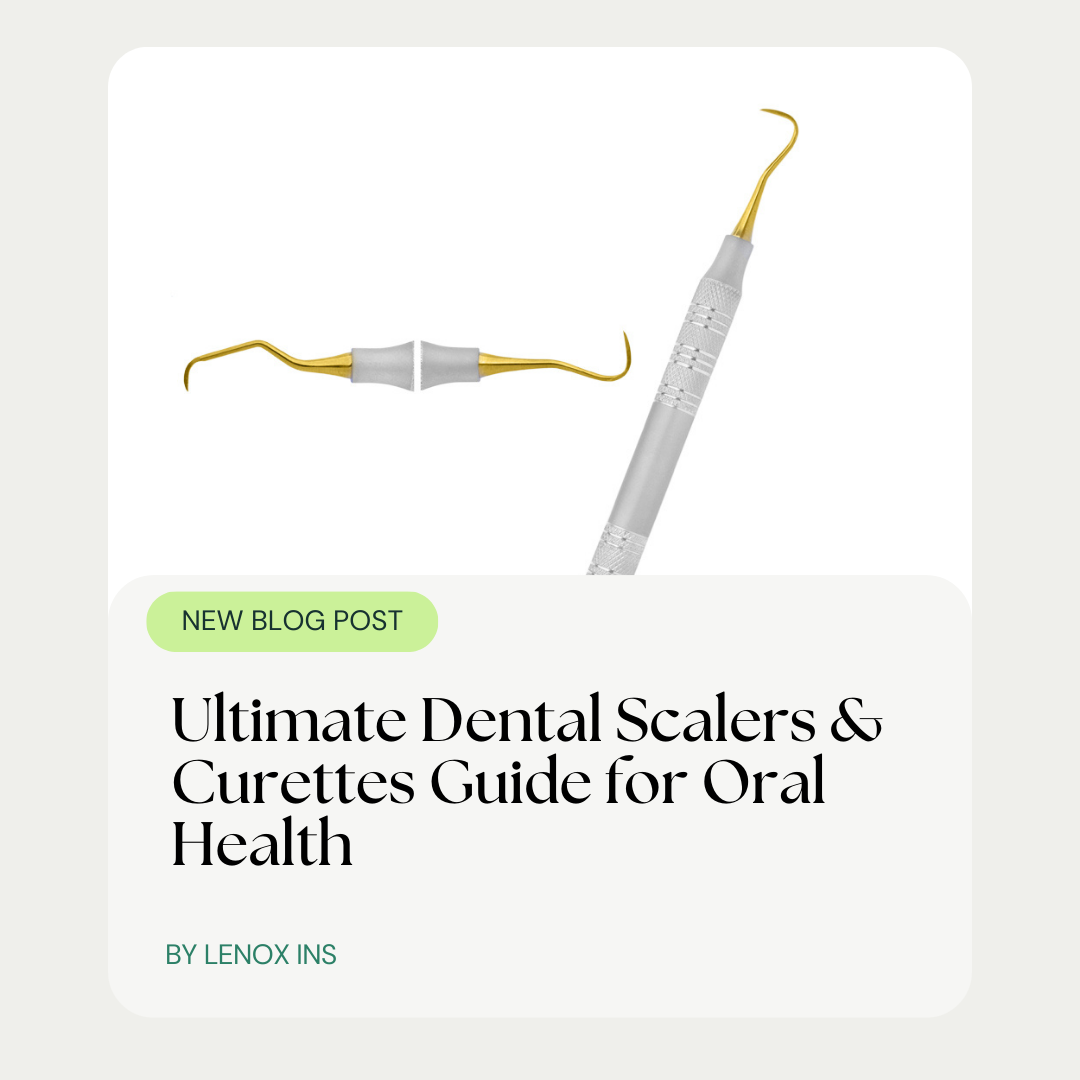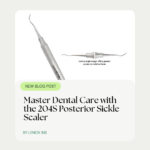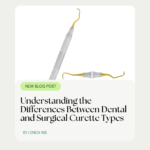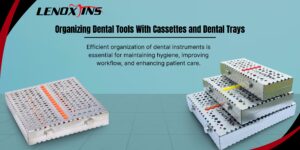Ultimate Dental Scalers & Curettes Guide for Oral Health
- lenoxinstro
- November 22, 2024
- Dental Instruments, Dental Surgical

Do you ever wonder if the tools you use significantly impact your dental hygiene practice? This guide delves into the world of dental scalers and curette sets, central to effective oral care. We’ll unpack their benefits, illustrate proper usage techniques, and advise on maintaining their precision. By understanding these tools, you’re equipping yourself to tackle one of the most persistent problems in dental health: effective plaque and tartar removal. With insights on the latest advancements and tips for selecting the optimal instruments, this post promises to refine your approach to oral therapy and elevate your practice’s standard of care.
Understanding Dental Scalers and Curettes in Oral Care
Dental scalers and curettes are instrumental in maintaining oral hygiene, each serving its specific function in infection control and dental care. Scalpel-like in precision, scalers are designed to remove dental composite and calcified deposits from teeth, particularly from the flat surfaces of premolars and the front teeth. Curettes, on the other hand, have a spoon-like end ideal for cleaning out periodontal pockets and delicate areas. Selecting the correct tool is key to ensuring effective treatment and patient comfort. This section offers insights into the different types, their uses, and the vital role they play in preventing dental diseases. Gracey Curettes
The Role of Scalers and Curettes in Dental Hygiene
Dental scalers and curettes are fundamental dental instruments crucial for thorough oral hygiene. Their correct use is vital for scraping tartar off the surfaces around molars and other hard-to-reach areas. Skilled hands use these tools not only to clean but also to detect areas of decay or damage that might require further attention, supporting overall dental health.
Appropriate sterilization protocols are a must for these instruments to ensure patient safety and prevent cross-contamination. Regular maintenance and care of scalers and curettes prolong their life and ensure dental professionals can effectively remove calculus, manage soft tissue, and maintain bone health without causing unnecessary discomfort to the client.
Differences Between Dental Scalers and Curettes
Dental scalers and curettes offer distinct functionalities that are tailored to specific dental procedures. A scaler usually has a pointed tip designed to access and remove tartar and plaque from the tooth‘s surface. On the other hand, a curette features a rounded tip perfect for subgingival cleaning within periodontal pockets. While both may come into contact with a sharpening stone to maintain their effectiveness, the precision required in their maintenance reflects their unique operational purposes, akin to the distinction between fine-tuned instruments used in neurosurgery and the more robust nature of wire or forceps manipulation.
When deploying a dental scaler, a professional is equipped to effectively target the supra-gingival areas between teeth, breaking down calculus with a decisiveness similar to a surgeon using a syringe for precision medication delivery. Curettes, however, are fashioned to delicately navigate the gum line and root surfaces to extract plaque build-up, ensuring a gentle yet thorough cleaning process. This nuanced approach responds to a patient‘s need for minimally invasive care, mirroring the patient-centered precision central to all medical fields, from dental care to neurosurgery.
Types of Dental Curettes and Their Specific Uses
Dental curettes play a critical role in the process of curettage, an essential aspect of periodontal therapy. These tools are expertly crafted to remove plaque and calculus from below the gumline, effectively helping to halt the progression of gum disease. Curettes come in a variety of shapes and sizes, each tailored for specific areas of the mouth, ensuring precision and patient comfort during periodontal maintenance. Gracey Curettes
For example, the Gracey curette, a commonly used tool, is specifically designed for cleaning particular quadrants of the mouth, allowing hygienists to meticulously remove biofilm without damaging delicate tissue. Unlike the more general tweezers or latex gloves that serve broad utility, dental curettes are akin to a sculptor’s specialized chisels, each adapted to refine a certain contour of the dental landscape. Their use by skilled practitioners exemplifies the ear for detail essential in oral health care, ensuring thorough cleaning in even the most challenging areas of the mouth.
Importance of Instrument Selection in Dental Procedures
Choosing the right surgical instrument for dental procedures is akin to an artist selecting the perfect brush for a masterpiece. A dental scaler with a scalpel-sharp edge can meticulously compare to remove tartar from the enamel, much like a precise incision on skin. This accuracy is essential for minimizing tissue trauma and promoting a smoother recovery.
On the flip side, a dental curette‘s spoon-shaped end is designed for gentle subgingival cleaning, crucial for preserving gum integrity. The selection of this instrument over others reflects an understanding of the delicate balance between thorough cleaning and patient comfort, ensuring the best possible outcomes for oral health.
Benefits of Using Dental Scalers and Curette Sets
Utilizing dental scalers and curette sets provides significant advantages for oral health care, enhancing the removal of stubborn plaque and preventing gum disease through precision instrumentation. This essential dental equipment, including specific tools like the rongeur for cotton placement or trimming tissue, contributes to more accurate bone grafting procedures and the careful treatment of conditions like chalazion. Focused on efficiency, these instruments improve both procedural outcomes and patient experiences by reducing chair time. In the following sections, we will delve into how these benefits manifest in clinical practice, from a practitioner’s skillful technique to the seamless integration of specialized tools.
Enhancing Oral Health Through Effective Plaque Removal
Effective plaque removal is paramount to oral health, and the utilization of dental scalers and curettes enhances the debridement process. Titanium-crafted instruments glide along the tooth and root surfaces, meticulously removing plaque without damaging the enamel or gums. This thorough cleaning by professionals helps prevent periodontal disease and promotes a healthy oral environment.
Root-focused care, particularly through the use of dental curettes, plays a crucial role in preventing tooth loss and infection. By skillfully scraping away hardened calculus that a toothbrush can’t reach, dental professionals protect the integrity of both the tooth and its supporting structures. The precision of these tools ensures patients leave the dental office with a deeper clean, fostering improved oral hygiene and overall health.
Preventing Gum Disease With Proper Instrumentation
The strategic use of a retractor and curette in dental practices throughout the United States underscores their role in staving off gum disease. When professionals employ a retractor to improve visibility and access, alongside a curette to meticulously clear away plaque and calculus, they significantly diminish the risk of periodontal conditions. By thus maintaining the integrity of the gumline, they enhance patient outcomes and comfort, ensuring each individual leaves the dental chair with healthier gums.
Incorporating a cannula for precise delivery of treatments complements the use of scalers and curettes, forming a comprehensive defense against gum disease. The precise removal of harmful bacterial colonies, when combined with well-executed techniques that protect against tissue damage, results in a proactive approach to oral healthcare. Dental experts who harness these instruments are not merely cleaning teeth; they’re crafting a foundation for long-term oral wellness.
Improving Patient Outcomes With Precision Tools
Integrating dental scalers and curette sets into patient care allows dental professionals to enhance patient outcomes significantly. The use of curette dentali, akin to stapes in surgical procedures, ensures precise removal of calculus and debris, leading to improved gum health and reduced risk of periodontal disease. These high-precision tools, in conjunction with personal protective equipment, safeguard both patient and practitioner, establishing a clinical environment focused on efficacious treatment and wellbeing.
Dental practitioners recognize that the meticulous use of instruments like scalers and curettes is akin to an artist using scissors to precisely cut a silhouette. This accuracy aids in the gentle treatment of sensitive dental structures, improving patient comfort during and after the procedure. By adopting such precision tools, dentists can offer care that not only addresses immediate concerns but also contributes to the long-term oral health of their patients.
Reducing Procedure Time With Efficient Techniques
Efficiency in dental care is crucial, and incorporating dental scalers and curette sets enables professionals to expedite procedures significantly. For instance, when using a dental dam in endodontics, the area of interest is isolated, and with high-quality steel instruments, clinicians swiftly remove calculus buildup. The resulting precise and focused technique saves time, creating a smoother patient experience and allowing practitioners to manage their workflow more effectively.
The utilization of equipment like dental suction or vacuum systems in conjunction with curettes streamlines the removal of debris during oral care, further reducing procedure time. This proves particularly beneficial in treatments such as deep cleanings where every second counts. By enhancing the efficiency of these procedures through skilled technique and precision tools, dental professionals optimize care, offering quicker relief to patients and preserving the health of critical structures within the oral cavity.
Proper Techniques for Using Dental Scalers and Curettes
Mastering the use of dental scalers and curettes requires learning proper techniques to ensure the utmost safety and effectiveness of oral care treatments. This section provides a comprehensive step-by-step guide to scaling procedures, focusing on the correct angulation and stroke methods necessary when working with anterior teeth. It underlines the importance of safety measures to protect both patients and dental professionals, utilizing syntettes and tools like hemostats and pliers for precision. Additionally, it highlights common mistakes to avoid during instrumentation, framing dilation and curettage in the dental context. Each ensuing topic offers practical insights, underlining these tools’ relevance for successful periodontal maintenance.
Step-by-Step Guide to Scaling Procedures
Initiating the dental scaling process, the clinician, equipped with a dental scaler of an appropriate diameter, begins by examining the teeth under magnification. Using a dental loupe, critical for orthodontics and detailed dental work, they can identify the precise angle needed to effectively remove tartar build-up without damaging the enamel. The precision in angulation is paramount, evoking the careful approach needed for a biopsy, where every millimeter matters.
Once the tooth surface is fully assessed, the dental professional gently inserts the scaler at the determined angle to meticulously detach and eliminate dental calculus. This action is performed with a series of calculated strokes, each crafted to ensure comprehensive plaque removal while preserving the structural integrity of the teeth and gums. Their technique mirrors the focused dedication seen in orthodontics, where attention to detail dictates the success of a patient‘s treatment journey.
Effective Angulation and Stroke Methods
Mastering the correct angulation and stroke technique with dental scalers and curettes is a foundational skill for any dental hygienist. The adept positioning of the instrument at a 45-to-90-degree angle to the tooth surface is akin to the precise positioning of a chisel before a stone is struck. This precise angulation allows for the efficient removal of calculus, all the while preserving the integrity of the tooth enamel and the delicate gingival tissue.
Each stroke with a scaler or curette should be methodical and deliberate, ensuring that all dental biofilm and tartar are removed effectively. Dental professionals often compare this practice to a cart carefully loaded with precision, making sure not to overload or miss any items. Similarly, they must use each stroke to clear the oral cavity of harmful buildups thoroughly. Between patients, instruments are treated with medical-grade disinfectant, ensuring the highest standard of care and maintaining the sterility of the work environment, much like the preparations for a sinus lift where asepsis is paramount.
Safety Measures to Protect Patients and Practitioners
Ensuring patient and practitioner safety during the use of dental scalers and periodontal curettes necessitates strict adherence to infection control protocols. Practitioners employ surgical-grade stainless steel instruments that can withstand rigorous sterilization, minimizing the risk of cross-contamination. Moreover, the careful handling of these sharp tools, much like the precision required for surgical sutures, is crucial to prevent accidental injuries and maintain a safe clinical environment.
Before and after each procedure, diligent cleaning and sterilization of dental instruments, including the hoe scaler and curettes, are imperative. This meticulous approach not only protects the patient from potential infections but also prolongs the lifespan of the instruments. Effective safety practices, akin to those in surgical settings, establish a protective barrier around the therapeutic encounter, ensuring a seamless and secure experience for everyone involved.
Common Mistakes to Avoid During Instrumentation
One common mistake in scaling and root planing is applying too much pressure, which can result in tissue trauma and discomfort for the patient. Just as an otoscope used in ophthalmology enables a detailed examination without harming the eye’s delicate structures, dental instruments should likewise be handled with utmost care. High-handedness similar to that leading to unnecessary force in a dental extraction, if applied in scaling, can damage the enamel or cause gum recession.
Another oversight often seen is the neglect of the proper angulation for instrument insertion, which is paramount to carry out an effective debridement. A dental professional must maneuver the scaler and curette with the precision of a surgeon to avoid gouging the soft tissue or missing plaque deposits. Missteps here not only undermine the treatment’s efficacy but also exacerbate patient recovery times, much like an imprecise incision could complicate a routine surgical procedure.
Maintenance and Care for Dental Scalers and Curette Sets
Maintaining the integrity and effectiveness of dental scalers and curette sets is crucial for safe and efficient oral care. In this section, we’ll guide you through practical cleaning and sterilization protocols that ensure the elimination of pathogens from your instruments. We will also detail sharpening techniques to keep your tools in top condition for optimal performance. Proper storage solutions are essential to extend the lifespan of these precision tools, while also recognizing when the time comes to replace them is a skill unto itself. Dive into the nuances of these maintenance practices to ensure your dental armamentarium, including instruments like tongue depressors and amalgam carriers, continues to perform at the highest standard. Gracey curettes
Cleaning and Sterilization Protocols
Adherence to meticulous cleaning and sterilization protocols is non-negotiable in periodontology to safeguard against the transmission of pathogens. Surgical-grade scalers and curettes must undergo a thorough decontamination process after each use, involving mechanical scrubbing followed by autoclaving—a technique akin to the sterilization standards in surgery. This not only ensures a pristine set of tools for scraping away dental plaque but also extends the life of the instruments, much like a mirror‘s clarity is preserved through regular, careful cleaning.
For dental professionals, the responsibility of maintaining a sterile environment parallels that in any surgery setting, demanding precision and attention to detail. Each tool, from explorers to dental mirrors, is systematically disinfected to remove biological debris before being exposed to high-pressure steam sterilization. Such rigorous procedures reflect the meticulous nature of dental care, ensuring that each instrument, whether used for delicate scraping or examining the oral cavity, meets the highest hygiene standards.
Sharpening Techniques for Optimal Performance
Maintaining the cutting edge of dental scalers and curettes is crucial for effective tartar removal and patient comfort. Regular sharpening preserves the precision of these tools, allowing practitioners to deftly remove calculus without exerting undue pressure, which could harm gum tissue. Dental professionals typically employ sharpening stones, honing each instrument at the correct angle to restore its fine edge, akin to a chef sharpening knives to ensure clean cuts.
Sharpening these dental instruments not only enhances their performance but also extends their usable life, offering a cost-effective solution for dental practices. To achieve this, each scaler and curette must be evaluated regularly for dullness and restored using proven techniques. When instruments are kept sharp, dental professionals can provide more efficient care, minimizing procedure time and improving the overall patient experience.
Storage Solutions to Prolong Instrument Lifespan
Proper storage solutions are vital for prolonging the lifespan of dental scalers and curette sets, ensuring their readiness and efficacy for every procedure. Dental professionals should store these precision instruments in designated, dry areas to prevent corrosion and damage. Instruments like curettes, which are crafted with fine edges for gentle yet thorough cleanings, particularly benefit from protective storage that maintains their sharpness and structural integrity.
Effective storage systems can help organize dental scalers and curettes in a way that prevents accidental dulling, damage, or loss. Using racks, cases, or holders designed for dental instruments not only protects them from environmental factors but also streamlines the workflow, allowing practitioners quick and easy access. Tailoring storage solutions to these instruments underlines a dental practice’s commitment to quality care, mirroring the meticulous attention given to the clinical setting itself.
Signs That Instruments Need Replacement
Recognizing when dental scalers and curettes require replacement is crucial for effective oral care. A clear indication is the instrument’s inability to hold a sharpened edge despite correct techniques, leading to inefficient calculus removal and possible discomfort for the patient. In such instances, the tool has likely reached the end of its lifespan, and continuing to use it can compromise patient care as well as violate professional hygiene standards.
An additional sign that a scaler or curette needs replacing is visible wear or damage, such as bent tips or surface pitting, which hinder the instrument’s functionality and could potentially introduce bacteria to sterile environments. Dental practices are advised to conduct routine inspections, and if such irregularities surface, take swift action to replace the compromised instruments to maintain the high-quality care patients trust and expect.
Advancements in Dental Scalers and Curette Technology
As dental care professionals continuously seek to enhance patient comfort and clinical efficacy, dental scalers and curette sets have seen significant advancements. Innovations in instrument design and materials have led to more durable and efficient tools, while the integration of ultrasonic scalers in dental practices has revolutionized plaque and calculus removal. Ergonomic handles and grips cater to practitioner comfort, reducing fatigue during procedures. Looking ahead, emerging trends in dental instrumentation promise to further refine the precision and effectiveness of periodontal treatments. This section explores these developments and their impact on oral healthcare. curette sets
Innovations in Instrument Design and Materials
The dental industry has witnessed significant advancements in the design and materials of scalers and curettes, leading to enhanced durability and patient comfort. Innovations such as lightweight, ergonomic handles made from advanced composites reduce hand fatigue among practitioners, while the introduction of sharper, more resilient blade materials allows for more efficient calculus removal. These upgrades reflect the industry’s commitment to improving the precision and comfort of periodontal care.
Today’s scalers and curettes also benefit from antimicrobial coatings that help inhibit the growth of bacteria, ensuring a safer environment for both dental professionals and patients. This cutting-edge integration of materials science into dental instruments aligns with the need for stringent infection control measures in dental practices, offering peace of mind while executing critical oral hygiene procedures.
Integration of Ultrasonic Scalers in Dental Practices
The integration of ultrasonic scalers in dental practices represents a leap forward in patient care, effectively supplementing traditional hand scaling methods. Dentists appreciate these advanced tools for their ability to swiftly break down plaque and calculus with high-frequency vibrations, enhancing patient comfort and reducing procedure time. Ultrasonic scalers have become an essential part of periodontal therapy, valued for their minimally invasive approach and precise cleaning capabilities.
With the adoption of ultrasonic technology, dental professionals can provide more thorough cleanings, particularly in deep periodontal pockets where manual tools may fall short. These devices irrigate and flush out bacteria from beneath the gums, promoting faster healing and less post-procedural discomfort. As a result, ultrasonic scalers not only elevate the standard of oral care but also reinforce the commitment of the dental community to progressive treatments that prioritize patient well-being.
Benefits of Ergonomic Handles and Grips
Ergonomic handles and grips on dental scalers and curettes are a game-changer for practitioners who perform multiple procedures daily. These features reduce hand strain and enhance precision, directly impacting the quality of patient care. With better grip comes improved control over the instruments, allowing for cleaner removal of plaque and calculus without excessive force that can cause patient discomfort.
The implementation of ergonomic designs addresses common pain points for dental professionals, such as repetitive motion injuries and fatigue. With the comfort of dental staff in mind, these advancements also translate to more focused and efficient treatments. In essence, the benefits of ergonomically designed dental instruments reach beyond the practitioner, ensuring patient procedures are both effective and comfortable.
Future Trends in Dental Instrumentation
The dental industry continues to push the envelope, developing smarter scalers and curettes that integrate digital technology. Dentists may soon have access to instruments with sensors that provide real-time feedback on cleaning efficacy and pressure application, maximising patient safety and further refining the scaling process. This progression aligns with the demand for precise, data-driven dental care, aiming to circumvent human error and standardize excellence in periodontal treatments.
Another exciting trend is the evolution of materials used in dental instruments, with researchers looking at biocompatible and bioactive coatings that not only resist wear but also release therapeutic agents to promote healing. The future of dental scalers and curettes looks set to incorporate these advanced coatings, potentially reducing inflammation and enhancing post-procedural recovery, thereby responding directly to patients’ needs for quick, comfortable healing.
Choosing the Right Dental Scalers and Curette Sets for Your Practice
Selecting the ideal dental scalers and curette sets is a critical decision for any dental practice, demanding careful consideration of various factors. When evaluating instruments, practitioners must weigh the merits of different brands and manufacturers, ensuring they choose tools that align with clinical needs and standards. Additionally, budgeting for high-quality dental tools is an investment in patient care and practice efficacy. Practical tips and purchasing recommendations guide clinicians in making informed decisions, prioritizing durability, and precision. These considerations are the bedrock of selecting dental instruments that enhance the quality of oral care services provided.
Factors to Consider When Selecting Instruments
When selecting dental instruments, practitioners must evaluate the material and craftsmanship. High-quality stainless steel offers durability and ease of sterilization, while a well-balanced instrument may improve handling and reduce fatigue. Dental professionals seek tools that promise long-term use and high effectiveness in removing plaque and calculus, thereby safeguarding patient oral health.
Another consideration is the design of the instrument, particularly its adaptability to various dental anatomies. A scaler or curette that features an ergonomic handle can minimize the strain on a dentist’s hands during prolonged procedures. An investment in instruments that provide such ergonomic benefits can lead to a more precise and comfortable experience both for the practitioner and their patients.
Comparing Brands and Manufacturers
When comparing brands and manufacturers of dental scalers and curettes, dental professionals should consider the reputation and history of the company in producing high-quality dental instruments. Factors like precision engineering, superior quality materials, and ergonomic design play pivotal roles in instrument selection. Renowned brands often deliver products that stand the test of time, exhibiting the resilience needed for frequent sterilization and the nuanced performance required for delicate periodontal work.
Dentists can benefit from researching manufacturers that specialize in dental scalers and curettes, as many offer unique features such as specialized coatings that reduce wear or grips that enhance comfort during long procedures. Seeking out reviews, testimonials, and clinical studies can provide valuable insights into how different instruments perform in practice, guiding practitioners towards making well-informed decisions that align with the specific needs of their dental practice and patient care standards. All of our hygiene instruments come from authoritative publishers.
Budgeting for High-Quality Dental Tools
Allocating funds for high-quality dental tools is an investment in the efficacy and reputation of a dental practice. Dental scalers and curettes crafted from premium materials not only enhance the precision of periodontal treatments but also stand up to the rigors of sterilization and repeated use. Practices should view these instruments as long-term assets that contribute to patient satisfaction and outcomes, ensuring they allocate sufficient resources to acquire the best tools available.
When budgeting for dental scalers and curettes, practitioners must consider not only the upfront cost but also the value these instruments bring over time. Quality dental tools may carry a higher initial price; however, their durability and efficiency can lead to reduced replacement costs and increased productivity. Dental professionals should assess the long-term benefits of their investment, recognizing that superior instruments can improve the oral care experience for both patients and the dental team.
Purchasing Tips and Recommendations
When investing in dental scalers and curette sets, practitioners should focus on the instruments’ adaptability and comfort. Seek out tools with ergonomic designs that alleviate hand fatigue, allowing for prolonged periods of use during intricate periodontal procedures. Additionally, it’s advisable to select sets that offer a variety of tip shapes and sizes, enabling clinicians to perform a comprehensive scale and root planing on a diverse patient population without compromising precision or comfort.
In making purchasing decisions, dentists may benefit from contacting manufacturers for sample products or attending dental trade shows to physically evaluate the instruments. Such direct experiences facilitate an informed choice, ensuring the selected tools meet the dentist’s specific handling preferences and the nuanced needs of their practice. Subsequently, this careful selection process contributes to higher standards of patient care and enhances the overall efficiency and reputation of the dental clinic.
Conclusion
Dental scalers and curette sets are fundamental to achieving superior oral hygiene and preventing gum disease through meticulous plaque removal and the preservation of gum integrity. The precise use of these specialized tools not only enhances patient comfort but also allows for more efficient procedures, underlining their critical role in modern dentistry. Proper maintenance, sterilization, and the adoption of ergonomic and advanced instruments further optimize dental care, underscoring the commitment to patient well-being. As dental professionals integrate these essential tools into practice, they ensure the delivery of high-quality, precise, and effective oral care that patients trust.





